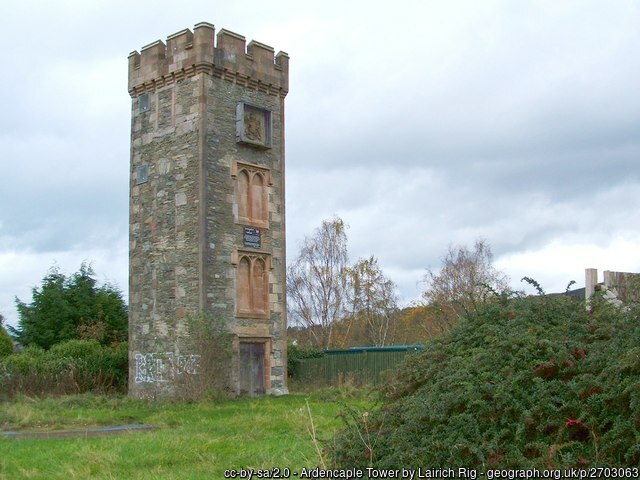Ardencaple

Ardencaple Details
Ardencaple, ?site of C12 castle; site of C16 tower of the MacAuleys rebuilt C18 into mansion, largely demolished
- Closest To: Helensburgh
- Access: Free Public Access
- Grid Reference: NS282830
Ardencaple Castle is a tall square tower which is the only surviving portion of a large mansion that was mostly demolished in the late 1950s. Today it is surrounded by housing and easily seen from public footpaths, although it is not possible to go inside. It was the centre of a lordship of some description in 1296, when King Edward I took the fealty of Maurice/Murdoch of Ardencaple, and two men who were presumably brothers, Duncan and Alan, sons of Aulay/Amlaib amongst others of Dunbartonshire. There is no evidence, however, to sustain the suggestion that a castle stood here in the 12th century, as is sometimes suggested.
There was, however, a significant tower house here in the late 16th century, shown by Timothy Pont as “Arncappil” as being a four storey tower house with two sets of windows, consistent with a late 15th/early 16th century “great tower”. The designs of Robert Adam in the 18th century show that the southern portion of the mansion with the massive bow window, post-dated the older structures to the north, and on balance it seems likely that the great tower formed a significant part of this structure, the surviving square tower attached to its north-west corner, although it does seem to have been reduced in height. It is possible that the early lords of Ardencaple were an offshoot of the earls of Lennox, but it is not until the early 16th century that much is known for certain of their family. In 1513, an Aulay Ardencaple of that Ilk is known, perhaps the same as was escheated of his goods in 1529 – and it seems likely that he was related to Robert of 1489 and Alexander of 1473. It is most likely that one of these men was responsible for the erection of the great tower, or another Alexander son of Aulay who was active in the reign of James V. The clan fortunes declined in the 17th century as the result of feuds, and in the 18th century started to sell off their lands. When the 12th laird died in 1767, the castle roof had fallen in and he had moved out. The estate was bought by the Duke of Argyll, who restored and extended the castle. It was sold again in 1852 and 1923, and then requisitioned by the Navy in 1939. In 1957 the government took the decision to demolish most of it to build military accommodation, leaving only the tall tower to act as a beacon and navigational aid.
Become a supporter of my work to access a more detailed history